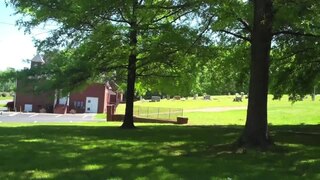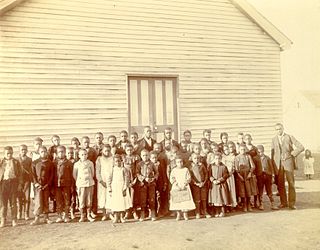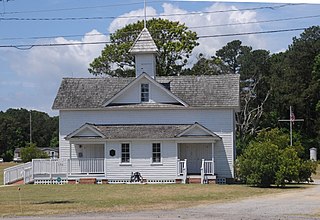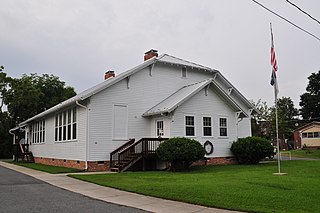
Currituck County is the northeastern most county in the U.S. state of North Carolina. As of the 2020 census, the population was 28,100. Its county seat is Currituck. The county was formed in 1668 as a precinct of Albemarle County and later gained county status in 1739. The name is "traditionally said to be an indigenous word for wild geese; Coratank." Currituck County is included in the Virginia Beach-Norfolk-Newport News, VA-NC Metropolitan Area. It is in the northeastern section of the state and is bounded by the Atlantic Ocean, Currituck Sound, Camden County, Dare County and the Commonwealth of Virginia. Currituck Court House, mentioned as early as 1755, was the name of the county seat. Today the words "Court House" have been dropped and only Currituck is used as the community name.

Coinjock is an unincorporated community and census-designated place (CDP) in Currituck County, North Carolina, United States. As of the 2010 census it had a population of 335. It is located on U.S. Route 158 between Barco and Grandy, about 20 miles (32 km) south of the Virginia state line, and is at mile marker 50 on the southern portion of the Albemarle and Chesapeake Canal, on the Intracoastal Waterway. Church's Island to the east of Coinjock in the Currituck Sound has a village called Waterlily, which uses the postal address of Coinjock as well. The island's name is due to a decayed church that was once a landmark of the tiny community. Coinjock is bordered by Currituck Sound to the east; the North River lies to the west. Its ZIP Code is 27923.

The Rosenwald School project built more than 5,000 schools, shops, and teacher homes in the United States primarily for the education of African-American children in the South during the early 20th century. The project was the product of the partnership of Julius Rosenwald, a Jewish-American clothier who became part-owner and president of Sears, Roebuck and Company and the African-American leader, educator, and philanthropist Booker T. Washington, who was president of the Tuskegee Institute.
The H. B. Sugg High School, also known as Farmville Colored School, is a historic segregated public high school for African American students located in Farmville, North Carolina, United States. It is listed as the H. B. Sugg School in the National Register of Historic Places listings since November 9, 2020 for its educational history and cultural history.

Liberty Colored High School is a former high school for African-American students in Liberty, South Carolina during the period of racial segregation. It originally was called Liberty Colored Junior High School. The building is now a community center known as the Rosewood Center. It is at East Main Street and Rosewood Street in Liberty. The school was built in 1937 on the site of a Rosenwald school that had burned down.

Cadentown School in Lexington, Kentucky was a primary public school for black children in the segregated Fayette County Public Schools from about 1879 to 1922. The building that originally housed Cadentown School, located at 705 Caden Lane, is no longer extant. However, the Rosenwald Fund School is listed on the National Register of Historic Places in Fayette County.

Mt. Zion Rosenwald School, also known as Mt. Zion-Rosenwald Colored School, is a historic Rosenwald School building located near Florence, Florence County, South Carolina. It was built in 1925, and is a rectangular frame building with tall exterior windows. It is a "two or three teacher" school building. Construction of the project was funded in part by the Julius Rosenwald Fund, which helped build more than 5,300 black school buildings across the south from 1917 to 1932.

Retreat Rosenwald School, also known as the Retreat Colored School, is a historic Rosenwald School located at Westminster, Oconee County, South Carolina.

Pine Grove Rosenwald School, also known as Pine Grove Colored School, is a historic Rosenwald school building located at St. Andrews, Richland County, South Carolina. It was built in 1923, and is a one-story, rectangular gable-front frame building. Its layout is a variant of the two-room schoolhouse and features large banks of tall narrow windows.

Currituck County Courthouse and Jail is a historic courthouse and jail located at Currituck, Currituck County, North Carolina. The original two-story section of the courthouse was built about 1842, enlarged in 1897, and a rear wing was added in 1952. The 1897 remodeling added a second floor to the original one-story wings and Classical Revival style design elements. The jail was built about 1857, and is a two-story, rectangular building with 32 inch thick brick walls. It is one of the oldest extant jails in North Carolina.

Jarvisburg Colored School is a historic school building for African-American students located at Jarvisburg, Currituck County, North Carolina. First built as a one-room school in 1868 on land donated by Mr. William Hunt Sr, an educated African American farmer in Currituck, His gift of land included property for a church. Replaced in the 1890s with a two-room building and again expanded in 1911 to its current size. It was in service from 1868 until 1950 when Currituck opened a Consolidated School and closed all the small African American county schools. The Jarvisburg Colored School is a two-story, frame building built of cypress wood with Queen Anne style design elements. It has a gable roof and features a pyramidal roofed bell tower with the original four foot wooden spire. It last housed a school in 1950. Today, the Jarvisburg Colored School serves as a Museum to share the stories of former students and histories of all the Colored Schools in Currituck County, North Carolina.

Franklin County Training School-Riverside Union School, formerly known as Louisburg Elementary School, is a historic school complex located at Louisburg, Franklin County, North Carolina. The complex includes three contributing Modern Movement style buildings: 1951 Classroom Building originally built for the Franklin County Training School; a 1960 Classroom Building ; and a 1964 Cafeteria Building. The complex was built to serve the educational needs of the African-American population of Franklin County. The school became the Riverside Union School in 1960, and remained so until 1968, when it became Louisburg Elementary School. In 2006, it became the central district office for Franklin County Schools. The Boys & Girls Clubs of Central North Carolina, Franklin County Unit, is also located on the campus.

Reid's Grove School is a historic Rosenwald school located near Gatesville, Gates County, North Carolina. It was built in 1927, and is a one-story, side-gable frame school with a prominent projecting single-bay gabled wing. It was one of seven schools in the county financed and constructed with the assistance of the Rosenwald Fund for the education of African-American children. It replaced an earlier school built in the 1880s. The building ceased its function as a school in 1951.
Snow Hill Colored High School, also known as Greene County Colored Training School and Rosenwald Center for Cultural Enrichment, is a historic Rosenwald School building located at Snow Hill, Greene County, North Carolina. It was built in 1925, and is a one-story, seven bay, "H"-shaped brick building. A six classroom addition was built about 1935. Also on the property are the contributing Mary M. Battle Monument and baseball field. The Snow Hill Colored High School is one of five schools that were constructed using Rosenwald funds in Greene County, including the Zachariah School.
Zachariah School is a historic Rosenwald School building located near Wooten's Crossroads, Greene County, North Carolina. It was built in 1920, and is a one-story, frame building sheathed in weatherboard and containing three classrooms. An auditorium was added in 1921, but removed about 1967–1969. Zachariah School closed in 1956. The Zachariah School is one of five schools that were constructed using Rosenwald funds in Greene County, including the Snow Hill Colored High School.

Harnett County Training School, also known as Harnett High School, is a historic school complex for African-American students located at Dunn, Harnett County, North Carolina. The complex was built between 1922 and 1956, and consists of one two-story and five single-story brick buildings. They include a gable front combined Gymnasium/Auditorium (1948); the two-story, 14 teacher, flat-roofed, Colonial Revival-style Rosenwald-funded Harnett County Training School (1922); a detached brick boiler room (1950); two, one-story, flat-roofed Library and Office Building and Cafeteria buildings (1956); and a one-story, flat-roofed Rosenwald-funded classroom annex added in 1927, now designated the Education Building.

Williamston Colored School, also known as E. J. Hayes School and E. J. Hayes High School, is a historic Rosenwald School building located at Williamston, Martin County, North Carolina, USA. It was built between 1930 and 1931 and is a one-story, five-bay, "H"-shaped, Colonial Revival style red brick building. It has two projecting pedimented gable-front wings, a hipped roof, and large decorative brick panels in a basketweave bond. A three classroom addition was built in 1939.

Walnut Cove Colored School, also known as London School, is historic Rosenwald School located at Walnut Cove, Stokes County, North Carolina. It was built in 1921 with a grant from Sears & Roebuck financier, Julius Rosenwald. A condition of the grant was that it had to have local matching funds. Therefore, it was built on land donated by John William Dalton and his brother George Samuel Dalton and with materials provided by The Dan River Lumber Company.
W. E. B. DuBois School, also known as Wake Forest Graded School (Colored), Wake Forest Colored High School, and Wake Forest-Rolesville Middle School, is a historic Rosenwald School building and school complex located at Wake Forest, Wake County, North Carolina. The elementary school was built in 1926, consists of a one-story, seven bay, brick veneer, main block with a rear ell and Colonial Revival style design elements. It has a side gable roof and front portico. The High School Building was built in 1939 with funds provided by the Public Works Administration. It is a one-story, rectangular brick block with a hipped roof and slightly projecting gabled portico. The Agriculture Building/Shop was brought to this site in 1942. It is a one-story, "L"-shaped brick building, with the addition built about 1952–1953.
Warren County Training School is a historic Rosenwald School located near Wise, Warren County, North Carolina. It was built in 1931, and is a large, one-story, nine classroom brick school. It measures approximately 222 feet by 58 feet, with a rear wing measuring 42 feet by 59 feet. Also on the property are the contributing teacherage (1925), brick cafeteria building, and brick agricultural building. The complex continued to operate as a school until 1970. The Warren County Training School is one of 25 schools that were constructed using Rosenwald funds in Warren County.



















